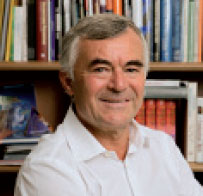Rino Rappuoli

Dr. Rino Rappuoli, PhD, is Global Head of Vaccines Research at Novartis Vaccines and Diagnostics, based in Siena, Italy. He earned his PhD in Biological Sciences at the University of Siena and has served as a visiting scientist at Rockefeller University in New York and Harvard Medical School in Boston. He is member of European Molecular Biology Organization and foreign associate of the American National Academy of Sciences. Published more than 450 works in peer-reviewed journals. He introduced several novel scientific concepts, the names of which became popular. Examples are the concept that bacterial toxins can be detoxified by manipulation of their genes (genetic detoxification, 1987), the concept that microbes are better studied in the context of the cells they interact with instead of artificial laboratory conditions (cellular microbiology, 1996), the use of genomes to develop new vaccines (reverse vaccinology, 2000), the observation that the genome of a species (pangenome, 2005) is larger than the genome of an organism of the same species. Several molecules he worked with became part of licensed vaccines. He characterized a molecule, CRM197, that today is the most widely used carrier for vaccines against H. influenzae, N. meningitidis and pneumococcus vaccines, and is used multiple times to vaccinate most children of the globe. Then he developed a vaccine against pertussis by engineering B. pertussis to produce a non toxic pertussis toxin antigen. This was the first rationally designed molecule approved for human use. Later he developed the first conjugate vaccine against meningococcus C that eliminated the disease in the UK in 2000. He pioneered the use of genomic information for vaccine development (reverse vaccinology). The first genome-derived vaccine against meningococcus B is now in Phase III clinical trials, several others are in earlier stages of development. Finally, in 1997 he obtained the regulatory approval for MF59, the first vaccine adjuvant approved for human use after the approval of aluminium salts in the 1920s. MF59 is now being used in many other experimental vaccines, the most advanced of which is a vaccine against pandemic influenza.
Vaccines to address the needs of 21st century society
During the 20th century, vaccines have eliminated most of the childhood diseases with the major exceptions of the diseases caused by meningococcus and respiratory syncytial virus (RSV). What is the role of vaccination in the 21st century? The first target will be to develop vaccines for meningococcal meningitis, which is perhaps the last disease that in a few hours can attack and kill healthy children and young people, and RSV that affects virtually every single child in the first few months of life. Fortunately, thanks to several revolutionary technologies developed during the last 30 years, including conjugation, genomics and new adjuvants, we are in the final stages to conquer meningococcal meningitis and new approaches are being tested for RSV. The second and perhaps most important target of vaccination in the 21st centurywill be to take care of the global health problems of this century. These include taking careof the aging population, with new vaccines targeting the diseases typical of the elderly with an aging immune system, to control emerging antibiotic resistance, to preventing cancer, taking care of the diseases present only in countries affected by poverty, and taking care of emerging diseases such as pandemic influenza. Overall, vaccines in the 21st century will have an increased safety, and will be used as an insurance to ensure health across all ages, for the entire life.





